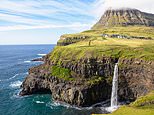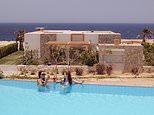
Jump ship with the next rising wave was the instruction when we arrived at Skuvoy, a tiny Faroe island with 30 inhabitants. But the dramatic cliffs, birds, sheep and a chance to experience village life made it well worth the rough crossing.
After a long walk, it was wonderful to be offered heimablidni (Faroese home dining) in a little stone cottage belonging to Tummas Frank Joensen and his wife Elizabeth, who served us a superb soup made of peaches, cream and fresh fish.
As it takes only an hour to reach this archipelago of 18 islands in the Atlantic Gulf Stream between Scotland and Iceland, the Faroes are an enticing getaway.
Majestic: Lucy Daltroff explored the Faroe Islands, an archipelago of 18 islands between Scotland and Iceland. Above is Mulafossur waterfall on the Faroese island of Vagar
Pictured is the archipelago’s largest island, Streymoy, which is about 30 miles long by ten miles wide
Atlantic airways flies on Mondays and Thursdays from Edinburgh Airport to Vagar, and from there it’s a 45- minute drive to the capital, Tórshavn. Or you can also fly — perhaps more cheaply — with a short stopover in Copenhagen.
Torshavn, with a population of 20,000, is on the largest island, Streymoy, which is about 30 miles long by ten miles wide. Its name, echoing the islands’ Viking heritage, means ‘Thor’s harbour’ and two out of every five Faroe Islanders call it home.
Much of it is dotted with brightly coloured houses with turfed roofs, and the city centre is small and historic, easily explored on foot and bursting with specialist shops and cafes. There is a new Hilton Hotel and other smaller hotels and guest houses.
There is a new Hilton Hotel (pictured centre right) and other smaller hotels and guest houses in Torshavn
One of the guest rooms at the new Hilton hotel. Double rooms are priced from £153
Faroese women dressed in traditional costumes
Sitting in one friendly restaurant, I spotted a group of women chatting animatedly while knitting vigorously. This proved to be a common sight, as knitwear is an important industry here.
Other employment for women is limited, and many who leave the islands to study don’t return. Most of the menfolk work in traditional industries, so there is a gender gap of about 1,500 at marrying age.
As a result, some farmers and fishermen use the internet to find partners and a high proportion of Asian women, many of them Filipino, marry the very conventional men.
The scenery is like a blend of Iceland, Scotland and Norway, yet the Faroe Islands are a self-governing region of Denmark (although, unlike Denmark itself, they are not in the EU).
A prosperous fishing industry has financed good roads and a series of tunnels linking the bigger islands, which means travelling by car is easy.
The infrastructure is well developed, with excellent wi-fi, comfortable accommodation, good food and designer knitwear. The downside is that prices are high (a litre carton of milk is £1.30, for example, and a mid-range bottle of wine £15).
The locals speak Faroese, a melodious language of Viking origin that was brought here by the first settlers in AD 800.
While the islands have long been a favourite haunt for photographers and birdwatchers, they have never attracted tourist hordes — although that might be about to change. The new drama Trom, recently shown on BBC4 and still on iPlayer, was filmed here.
Two out of every five Faroe Islanders call the city of Torshavn home. Pictured is the city’s marina
On a boat trip, Lucy enjoyed views of the nests and habitats of puffins (left). ‘The Faroes are an enticing getaway,’ she says
FASCINATING FAROES There are more sheep than people — 80,000, compared with 53,000.Only one village in the Faroes is not on the coast.The tap water is considered among the most refreshing in the world.There are 20 hours of daylight in the summer months.The archipelago has no real prison. Any serious criminals are sent to serve their time in Denmark.Many houses have grass roofs.
The weather is changeable, often fluctuating in the space of a few hours. But for spectacular landscapes, a powerful atmosphere and sheer quirkiness, the Faroes are unrivalled. Where else, for instance, would you stumble upon a ‘yarn-bombed’ rock, completely covered in knitting, inspired by a legend about a ‘troll woman’ who lived in a cave?
Our guide, Ingigerd, explained that the islands were first settled by Irish monks in about AD 700, then colonised by the Vikings, who were later converted to Christianity by the king of Norway.
A tooth-shaped point of land reaching out into the harbour is called Tinganes, which in Faroese means ‘parliament point’. This was where the islands’ legislature first met in the Viking period, which makes it one of the world’s oldest parliamentary meeting-places.
Just discernible at the tip of the promontory is a Viking sundial engraved into the rock. Although its exact origins are unknown, it is linked to honouring of the Norse god Thor.
The pure quality of light on the islands inspires the artists whose work is displayed in the small national art gallery, Listasavn Foroya. After I’d browsed for a while, Frida, the curator, took me downstairs to a room called ‘The Deep Blue’ that is lined from top to bottom in azure glass and mirrors, to express the depth and seeming infinity of sky and ocean — a totally immersive experience.
Above is Tinganes, a tooth-shaped point of land in Torshavn. This was where the islands’ legislature first met in the Viking period, which makes it one of the world’s oldest parliamentary meeting-places, Lucy reveals
Afterwards I wandered through the large park that surrounds the building, admiring the many unusual sculptures.
A popular excursion is to catch a boat from Vestmanna, on the west of Streymoy, to the bird cliffs. Before we entered the first gorge, a crewman distributed yellow hard hats to all the passengers, just in case rocks (or, I suppose, bird droppings) should fall on us.
Gunnar, our captain, began our trip by skilfully steering between spectacular rocks to give us the best views of the nests and habitats of puffins, guillemots, fulmars, kittiwakes and oystercatchers. Kirkjubour, a 15-minute drive or two-hour walk from Torshavn, is considered the cultural capital of the islands. It lies on the south-west coast of Streymoy, with gorgeous views west towards the islands of Hestur and Koltur, and south towards Sandoy.
A popular excursion is to catch a boat from Vestmanna (above), on the west of Streymoy, to the bird cliffs
Kirkjubour offers gorgeous views west towards the island of Koltur (pictured), reveals Lucy
Atlantic airways flies on Mondays and Thursdays from Edinburgh Airport to the isle of Vagar. Pictured is Sorvagsvatn, a jaw-dropping lake on the island
The village was important in the Middle Ages as the episcopal residence for the islands’ diocese, which was surrounded by 50 houses.
Most of these were washed away by a storm in the 16th century. What remain are the ruins of the impressive Magnus Cathedral from about 1300, the walls of which still stand at their full height.
Nearby is the whitewashed 12th-century Saint Olav’s Church, which is still in use today and never locked. A bricked-up hole in the north wall was once used by lepers, who were not allowed into the church but could listen to the services.
A stunning view of the islands of Vagar and Tindholmur. ‘[The Faroes] is one of the world’s most mysterious and magical landscapes,’ says Lucy
On Kirkjubour, you’ll find the ruins of the impressive Magnus Cathedral (above) from about 1300, the walls of which still stand at their full height
Above is the whitewashed 12th-century Saint Olav’s Church, which is still in use today and never locked
Barbara Fish House in Torshavn, pictured, is an excellent place to sample the fresh seafood of the Faroe Islands. On the right are some colourful fish dishes that are served up at the restaurant
The ‘Seal Woman’ sculpture on the isle of Kalsoy is framed by spectacular wild scenery
I met up with Joannes Paturrson, whose family have farmed on this ‘King’s land’ for 17 generations. His cosy home, built from Danish driftwood in the 11th century, is reputed to be the oldest wooden house in the world.
Another island, Kalsoy, has the most iconic sculpture on the Faroes.
It’s a long, steep, stepped walk to reach it but ‘Seal Woman’ is framed by spectacular wild scenery, with high waves sometimes crashing over the statue’s head.
According to Faroese mythology, seals are former humans who voluntarily sought death in the ocean but, once a year, stripped off their seal skins and amused themselves again as people, partying on land.
With 700 miles of coastline, it’s no surprise the islanders have always depended on the ocean for food, mainly white fish and salmon. Barbara Fish House in Torshavn is an excellent place to sample the fresh seafood.
Lamb is also common in local dishes, as there are 80,000 sheep here.
Few trees grow in the salty air but with miles of cliffs, mountains and waterfalls, this is one of the world’s most mysterious and magical landscapes.
Source link
CHECK OUT: Top Travel Destinations
READ MORE: Travel News



